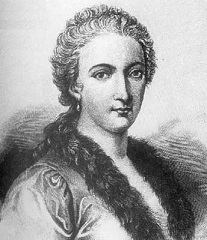 Article
Article- 29 pages
- Level: university
This article by Massimo Mazzotti discusses Maria Gaetana Agnesi, a child prodigy who obtained education and acclaim for her abilities in math and physics, as well as support from Pope Benedict XIV. But after the death of her father she abandoned her work in mathematics and physics and chose a life of service to those in need. In this article (published in 2001 in Isis: Journal of the History of Science Society, Vol. 92, no. 4, pgs. 657-683) Mazzotti writes:
Maria Gaetana Agnesi (1718-1799) is known as the author of a textbook on calculus that appeared in Milan in 1748. For the first time a woman was able to establish herself as a legitimate mathematician and publish her work…. In her Instituzioni analitiche she presented the most complete introduction to algebra, analytic geometry, and differential and integral calculus yet published in Europe. Far from being a tool to subvert traditional metaphysical assumptions and religious dogmas, Agnesi thought of mathematical analysis as an intellectual practice that could play an important role in the spiritual life of the believer….
In 1752 she renounced her rights to the family estate in exchange for an annuity that allowed her to host an increasing number of women in need and to devote all her time to their assistance. In 1759 she left the palazzo, moving to a more modest apartment nearby where she continued her catechistic activity and her volunteering at the Ospedale Maggiore. She worked with women from the urban lower classes, providing help and education to orphans, prostitutes, the elderly, the sick, and the mentally ill. Agnesi wanted to offer all of them the opportunity to embrace faith, whether to rescue them for dignified, useful lives or to enlighten the last part of their earthly paths. In 1771 a new charitable institution to assist the urban poor, the Pio Albergo Trivulzio, was opened in Milan. Archbishop Pozzobonelli asked Agnesi to become the director of the female department, which eventually housed about 450 patients…. Agnesi, who meanwhile had renounced all her possessions and was living in poverty, moved to the Pio Albergo Trivulzio to be closer to those she assisted. There she died of pneumonia in January 1799…. Her body was buried in a mass grave outside of Porta Romana, the southern gate of the town. Frisi tells us that, to those few who managed to contact her in her later years, Agnesi explained: “Man always acts to achieve goals; the goal of the Christian is the glory of God. I hope my studies have brought glory to God, as they were useful to others, and derived from obedience, because that was my father’s will. Now I have found better ways and means to serve God, and to be useful to others.”…
A wealthy family eager for social enhancement, a Church eager for new charismatic figures, and a reformist religiosity characterized by favorable views about the education of women and intellectual achievement: these were the conditions that made it possible for Agnesi to establish herself as a legitimate author of a mathematical treatise and as an advisor to the archbishop of Milan on theological matters. It can be suggested that the same religious reformism was a factor in the achievements of other eighteenth-century learned women, like Laura Bassi or Cristina Roccati….
Click here to access this article through JSTOR. Many libraries provide full access to JSTOR.
Click here for an 1801 English translation of Agnesi’s book, from Google Books.
